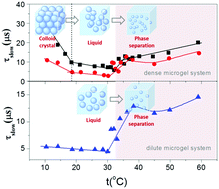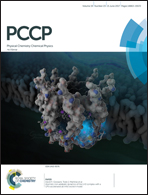Concentration dependent phase behavior and collapse dynamics of PNIPAM microgel by dielectric relaxation
Abstract
The dielectric behavior of thermo-sensitive poly-(N-isopropylacrylamide) (PNIPAM) microgel with three different concentrations was investigated for the frequencies ranging from 40 Hz to 110 MHz as a function of temperature from 10 to 60 °C. Two remarkable and temperature-dependent relaxation processes were observed. The slow relaxation originates from the segmental motion over the whole temperature range. The fast relaxation is due to the fluctuation of counterions below the lower critical solution temperature (LCST) and the interfacial polarization above the LCST. It was concluded from the temperature-dependent dielectric parameters that the microgel concentration will not influence the LCST but affects the phase behavior of the microgel suspension: the dense system experienced a colloidal crystal-to-liquid transition and volume phase transition, while the dilute system only underwent a volume phase transition. Based on the interfacial polarization theory, the electrical parameters for the constituent phases (permittivity, conductivity, and volume fraction of the microgel (εp, κp, ϕ) and the conductivity of water κa) and the water content in the microgel (fw) were calculated using Hanai's equation. In addition, the thermodynamics parameters of the two relaxations were calculated from the Eyring equation. The electrical and thermodynamic parameters indicate that the microgel concentration influences the volume, charge density, thickness of the electric double layer, and degrees of freedom of the segments of the microgel, thereby resulting in the differences in collapse dynamics.



 Please wait while we load your content...
Please wait while we load your content...